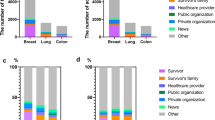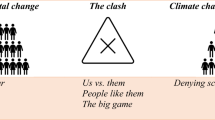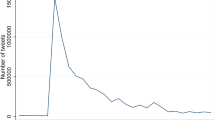Abstract
Objectives
Our objective was to elucidate the discussion points of circumcision on social media (SoMe) by looking at the Twitter activity.
Material and methods
Twitter searched for #circumcision hashtag via www.tweetarchivist.com, www.twitonomy.com, www.symplur.com. Total tweet numbers, most influencers, top users were documented. Tweets including female circumcision were excluded. The contents of the tweets were classified into four subgroups (medical, religious, social, and political) by two independent reviewers. All kinds of tweet activities were statistically analyzed.
Results
A total of 9795 users generated 15,989 tweets about circumcision in a 1 month period. Mean daily tweet activity was 532 for #circumcision. The content analysis revealed that 2224 (15.8%) medical, 1133 (8.0%) religious, 323 (2.2%) social and 10,470 (74.0%) political tweets have been sent out by the users. Contributors originated from 174 countries from 6 continents. Media organizations were accounted for 52% of the top 25 influencers in circumcision hashtag. The most common hashtags accompanying #circumcision were #HIV (4.9%), #babiesgotherpes (3.3%), #muslim (1.8%), #malegenitalmutilation (1.6%) respectively.
Conclusions
There is an increasing discussion about circumcision through SoMe . Our results provided that the discussion points are mostly driven by the media and the activists. The political tweets have been found to be the center of the discussion. SoMe usage should be increased by medical professionals for true information of the public.
This is a preview of subscription content, access via your institution
Access options
Subscribe to this journal
Receive 8 print issues and online access
$259.00 per year
only $32.38 per issue
Buy this article
- Purchase on Springer Link
- Instant access to full article PDF
Prices may be subject to local taxes which are calculated during checkout




Similar content being viewed by others
References
Male circumcision: global trends and determinants of prevalence, safety and acceptability. IWHO Library Cataloguing-in-Publication Data 2007. http://apps.who.int/iris/bitstream/handle/10665/43749/97892?sequence=1
Merrill CT, Nagamine M, Steiner C. Circumcisions Performed in U.S. Community Hospitals, 2005. HCUP Statistical Brief #45. January 2008. Agency for Healthcare Research and Quality, Rockville, MD. http://www.hcup-us.ahrq.gov/reports/statbriefs/sb45.pdf
Loeb S. Social media makes global urology meetings truly global: the influence of Twitter. BJU Int. 2015;115:175.
Dunsmuir WD, Gordon EM. The history of circumcision. BJU Int. 1999;83:1–12.
Coutinho K, Stensland K, Hyun G. Circumcision on the web: a comparison of quality, content, and bias online. J Pediatr Urol. 2014;10:688–92.
Gómez Rivas J, Rodríguez Socarrás M, Tortolero Blanco L. Social Media in Urology: opportunities, applications, appropriate use and new horizons. Cent Eur J Urol. 2016;69:293–8.
Rivas JG, Socarras MR, Patruno G, Uvin P, Esperto F, Dinis PJ, et al. Perceived Role of Social Media in Urologic Knowledge Acquisition Among Young Urologists: A European Survey. Eur Urol Focus. 2017 Jul 27. pii: S2405-456930168-7. https://doi.org/10.1016/j.euf.2016.11.010.
Rouprêt M, Morgan TM, Bostrom PJ, Cooperberg MR, Kutikov A, Linton KD, et al. European Association of Urology (@Uroweb): recommendations on the appropriate use of social media. Eur Urol. 2014;66:628–32.
Borgmann H, Loeb S, Salem J, Thomas C, Haferkamp A, Murphy DG, et al. Activity, content, contributors, and influencers of the twitter discussion on urologic oncology. Urol Oncol. 2016;34:377–83.
O’Kelly F, Nason GJ, Manecksha RP, Cascio S, Quinn FJ, Leonard M, et al. The effect of social media (#SoMe) on journal impact factor and parental awareness in paediatric urology. J Pediatr Urol. 2017;13:513.e1–.e7.
Wilkinson SE, Basto MY, Perovic G, Lawrentschuk N, Murphy DG. The social media revolution is changing the conference experience: analytics and trends from eight international meetings. BJU Int. 2015;115:839–46.
Salem J, Borgmann H, Bultitude M. et al. Online discussion on #KidneyStones: a longitudinal assessment of activity, users and content. PLoS ONE. 2016;11:e0160863
Author information
Authors and Affiliations
Corresponding author
Ethics declarations
Conflict of interest
The authors declare that they have no conflict of interest.
Rights and permissions
About this article
Cite this article
Ucar, T., Culpan, M., Caskurlu, T. et al. The activity and discussion points of #Circumcision through Twitter; a microblogging platform. Int J Impot Res 30, 249–252 (2018). https://doi.org/10.1038/s41443-018-0058-y
Received:
Revised:
Accepted:
Published:
Issue Date:
DOI: https://doi.org/10.1038/s41443-018-0058-y
This article is cited by
-
Correlation between Twitter mentions and academic citations in sexual medicine journals
International Journal of Impotence Research (2022)



